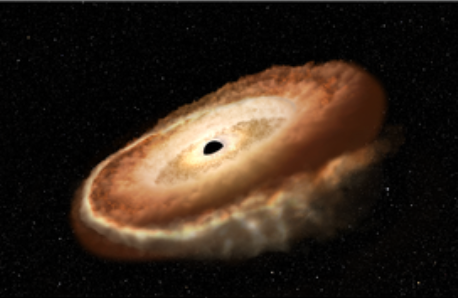Nasa’s Hubble Space Telescope sees black hole twisting a star into a ‘donut’

Astronomers have watched as a black hole tears a star into a “donut” and then eats it.
The process is one of the most violent and extreme in the universe: when a star gets too close to a black hole, it tears it up, eating the star but also spewing radiation out. It is known as a “tidal disruption event”.
Scientists have watched as that happens, using the Hubble Space Telescope to record the final moments of the star as it was eaten up.
Researchers hope to use the observations and other like it to better understand what happens when a star falls into the abyss and is torn apart in such a way.
Nasa’s Hubble Space Telescope is unable to see the process as it happens, since the new example is almost 300 million light years away. But they can see the light that is thrown out when it does happen, and examine that light for the clues to what happens to the star.
Researchers have seen many such examples of tidal disruption events around black holes. About 100 of them have been documented, throughout space and using a variety of different telescopes.
But it is much more unusual to see those tidal events using ultraviolet light, as in the recent study. An that light is helpful because it can explain what is happening to the debris, and about the black hole that released it.
Astronomers think that the light they are looking at comes from a very bright, donut-shaped ring of gas that once made up the star. The area is the size of our Solar System, swirling around a black hole at its centre.
“We’re looking somewhere on the edge of that donut. We’re seeing a stellar wind from the black hole sweeping over the surface that’s being projected towards us at speeds of 20 million miles per hour (three percent the speed of light),” said Peter Maksym from the Center for Astrophysics | Harvard & Smithsonian, in a statement.
“We really are still getting our heads around the event. You shred the star and then it’s got this material that’s making its way into the black hole. And so you’ve got models where you think you know what is going on, and then you’ve got what you actually see.
“This is an exciting place for scientists to be: right at the interface of the known and the unknown.”
Join our commenting forum
Join thought-provoking conversations, follow other Independent readers and see their replies
Comments
Bookmark popover
Removed from bookmarks